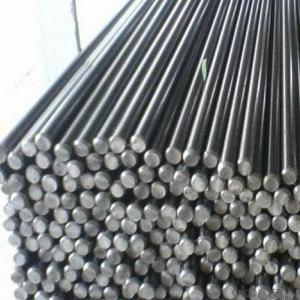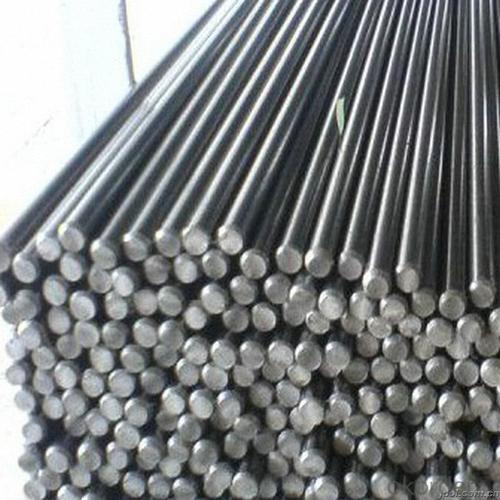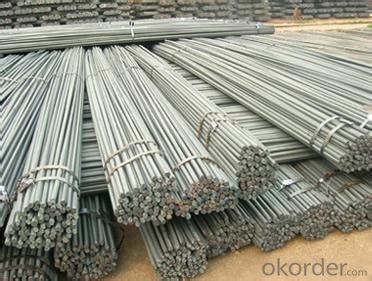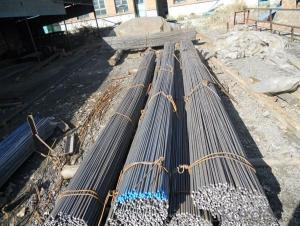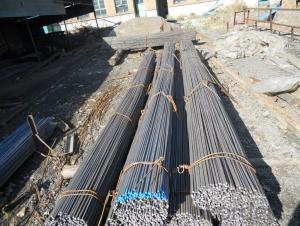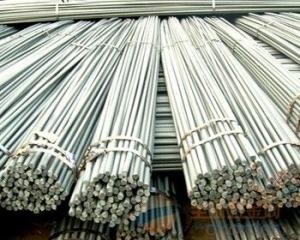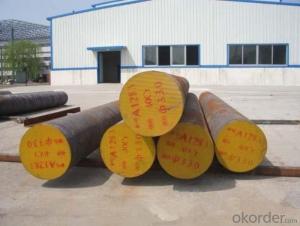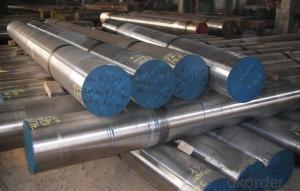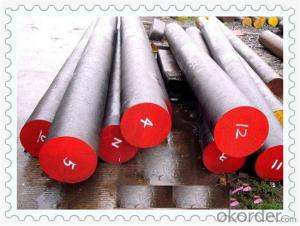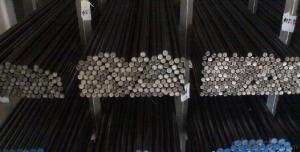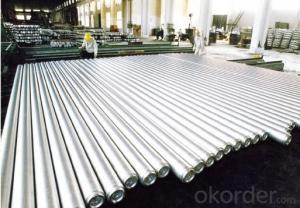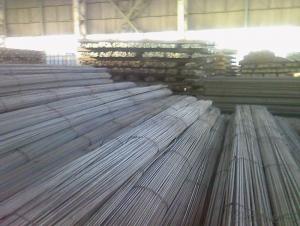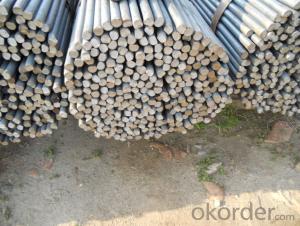Spring Steel 60CrMnA
- Loading Port:
- China Main Port
- Payment Terms:
- TT OR LC
- Min Order Qty:
- -
- Supply Capability:
- -
OKorder Service Pledge
Quality Product, Order Online Tracking, Timely Delivery
OKorder Financial Service
Credit Rating, Credit Services, Credit Purchasing
You Might Also Like

- Q: Can steel round bars be used for shafts or axles?
- Yes, steel round bars can be used for shafts or axles. Steel round bars are commonly used for these applications due to their high strength, durability, and ability to withstand heavy loads and torsional forces. They can be machined and shaped to fit specific requirements, making them suitable for various industrial and mechanical applications.
- Q: What are the advantages of using steel round bars in construction?
- There are several advantages of using steel round bars in construction: 1. Strength and Durability: Steel round bars are known for their exceptional strength and durability. They have a high tensile strength, which means they can withstand heavy loads and provide robust support. This makes them ideal for construction projects that require structural integrity and stability. 2. Versatility: Steel round bars come in various sizes and grades, offering versatility in construction. They can be easily shaped, bent, and welded to fit specific design requirements, making them suitable for a wide range of applications. Whether it's for building frameworks, reinforcement in concrete structures, or even decorative elements, steel round bars can be tailored to meet different project needs. 3. Cost-effectiveness: Steel round bars offer cost-effectiveness in construction due to their long lifespan and low maintenance requirements. They are resistant to corrosion, weathering, and pests, which reduces the need for frequent repairs or replacements. Additionally, their strength allows for the utilization of lighter construction materials, leading to potential cost savings in the overall project. 4. Fire Resistance: Steel round bars have excellent fire-resistant properties, making them a safe choice for construction. They do not burn, melt, or emit toxic fumes under high temperatures, which can be crucial in preventing the spread of fire and ensuring the safety of occupants. 5. Sustainability: Steel is a highly sustainable material as it is 100% recyclable. Using steel round bars in construction contributes to reducing environmental impact by minimizing waste and conserving natural resources. Additionally, the process of recycling steel requires less energy compared to manufacturing it from raw materials, making it an eco-friendly choice. 6. Availability and Quality Control: Steel round bars are readily available in the market, making them easily accessible for construction projects. Moreover, their production undergoes strict quality control measures, ensuring consistent and reliable material properties. This guarantees the structural integrity and safety of the constructed buildings or infrastructures. In conclusion, the advantages of using steel round bars in construction include their strength, versatility, cost-effectiveness, fire resistance, sustainability, availability, and quality control. These attributes make them a popular choice for builders and engineers seeking reliable and efficient materials for their construction projects.
- Q: What is the elongation of a steel round bar?
- The elongation of a steel round bar refers to the amount of lengthening or stretching the bar undergoes when subjected to an applied force or load.
- Q: Can steel round bars be painted?
- Yes, steel round bars can be painted. Painting steel round bars can help protect them from corrosion and enhance their appearance. However, before painting, the surface of the steel round bars should be properly prepared by cleaning, degreasing, and removing any rust or mill scale. This can be done using methods such as sandblasting, wire brushing, or chemical cleaning. Once the surface is adequately prepared, a primer specifically designed for steel should be applied to promote better adhesion of the paint. Finally, the desired paint can be applied to the steel round bars using brushes, rollers, or spray equipment. It is important to choose a paint that is suitable for outdoor use and provides sufficient protection against harsh weather conditions. Regular maintenance and periodic repainting may be required to ensure the longevity and durability of the painted steel round bars.
- Q: What are the safety precautions when handling steel round bars?
- To minimize the chance of accidents or injuries, it is important to adhere to several safety precautions when dealing with steel round bars. 1. Personal Protective Equipment (PPE) should always be worn. Safety goggles, gloves, steel-toed boots, and a hard hat are essential in safeguarding against potential hazards like flying debris, sharp edges, and heavy objects. 2. Proper lifting and carrying techniques are crucial. Due to the weight and bulkiness of steel round bars, it is vital to employ correct lifting methods to prevent strain or injury. Lift with your legs, maintain a straight back, and avoid twisting or jerking movements. If the bars are too heavy, seek assistance or employ mechanical aids like forklifts or cranes. 3. Ensure secure storage and stacking. Properly securing and organizing steel round bars when storing or stacking them is imperative. Use appropriate storage racks or A-frames to prevent tipping or falling, which could result in severe injuries. When stacking multiple bars, employ spacers or shims to maintain stability. 4. Be cautious of sharp edges. Steel round bars might possess sharp edges or burrs, necessitating care when handling. Wearing gloves is advised to protect your hands, and avoid dragging or sliding the bars to prevent cuts or abrasions. 5. Employ proper handling techniques. Maintain a firm grip when moving steel round bars and be aware of your surroundings. Do not swing or throw the bars, as they may strike someone or cause damage. Instead, walk slowly and steadily, ensuring clear pathways and ample space for maneuvering. 6. Inspect for defects. Prior to using steel round bars, examine them for any defects or damage that could compromise their structural integrity. Look for cracks, dents, or deformities. If any issues are detected, refrain from using the bars and report them to a supervisor or quality control personnel. 7. Observe fire safety measures. Steel round bars are highly flammable when exposed to extreme heat or sparks. Hence, avoid working near open flames or hot work areas. Keep fire extinguishers nearby and ensure that everyone is trained in fire safety protocols. By adhering to these safety precautions, the risks associated with handling steel round bars can be significantly minimized, creating a safer work environment.
- Q: Can steel round bars be used for making engine parts?
- Yes, steel round bars can be used for making engine parts. Steel is a widely used material in the automotive industry due to its high strength, durability, and heat resistance properties. Engine parts such as crankshafts, connecting rods, and camshafts can be made from steel round bars to ensure reliability and performance.
- Q: What are the different surface treatments available for stainless steel round bars?
- To enhance the appearance, improve corrosion resistance, and provide added protection for stainless steel round bars, there are various surface treatments available. Some commonly used surface treatments for stainless steel round bars are as follows: 1. Acid immersion: This process involves immersing the stainless steel bar in an acid solution to eliminate surface impurities and oxides. Acid immersion restores the natural corrosion resistance of stainless steel and results in a smooth and clean surface. 2. Chemical passivation: Passivation is a chemical treatment that forms a thin, protective layer on the surface of stainless steel. By eliminating free iron and other contaminants, passivation enhances the corrosion resistance of stainless steel. 3. Electrolytic polishing: This treatment involves immersing the stainless steel round bar in an electrolyte solution and applying an electric current. By removing a thin layer of material from the surface, electrolytic polishing creates a smooth, shiny, and corrosion-resistant finish. 4. Mechanical grinding and polishing: Grinding and polishing are mechanical processes used to improve the surface finish of stainless steel round bars. Grinding eliminates imperfections and roughness, while polishing creates a smooth and reflective surface. 5. Protective coating: Applying a protective layer to stainless steel round bars can provide additional corrosion resistance. Common coatings include electroplating with zinc or nickel, as well as organic coatings such as paints or powder coatings. 6. High-velocity shot blasting: This treatment involves bombarding the surface of the stainless steel round bar with small metallic or non-metallic particles at high speed. Shot blasting eliminates surface contaminants, scales, or oxides, resulting in a clean and textured surface. It is important to consider the desired end-use application and specific requirements for appearance and corrosion resistance when choosing a surface treatment for stainless steel round bars. Seeking advice from professionals or manufacturers can help determine the most suitable treatment.
- Q: Can steel round bars be used for making fasteners?
- Yes, steel round bars can be used for making fasteners. They are commonly used in the manufacturing of bolts, screws, and other types of fasteners due to their strength, durability, and ease of machining. Steel round bars provide the necessary mechanical properties and can be threaded or shaped to meet specific fastening requirements.
- Q: What are the typical dimensions of a steel round bar?
- The dimensions of a steel round bar can vary depending on the specific application and industry requirements. Generally, diameter sizes for steel round bars range from 1/4 inch to 24 inches. These sizes are often measured in increments of 1/8 inch or 1/4 inch. The length of a steel round bar is usually standardized at 20 feet, although shorter lengths may also be available. It is important to consider that these dimensions can significantly differ based on the grade and type of steel used, as well as the manufacturing process. Therefore, it is crucial to refer to the appropriate industry standards or consult a supplier for precise dimensions required for a particular project.
- Q: What are the different machining processes used for steel round bars?
- Some of the different machining processes used for steel round bars include turning, milling, drilling, and grinding. Turning involves rotating the bar against a cutting tool to remove material and create a desired shape. Milling uses a rotating cutter to remove material from the surface of the bar. Drilling involves creating holes in the bar using a rotating drill bit. Grinding uses an abrasive wheel to remove material and achieve a smooth surface finish on the bar. These processes are commonly used in metalworking industries to shape and refine steel round bars for various applications.
Send your message to us
Spring Steel 60CrMnA
- Loading Port:
- China Main Port
- Payment Terms:
- TT OR LC
- Min Order Qty:
- -
- Supply Capability:
- -
OKorder Service Pledge
Quality Product, Order Online Tracking, Timely Delivery
OKorder Financial Service
Credit Rating, Credit Services, Credit Purchasing
Similar products
Hot products
Hot Searches
Related keywords
